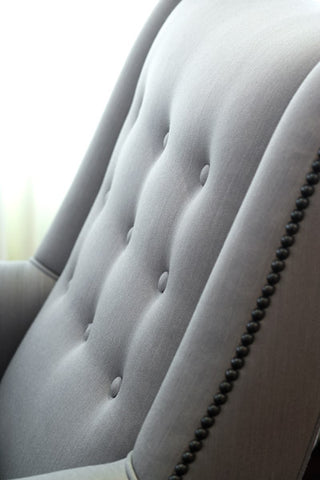Which of your fabrics work best for upholstery?
Regarding upholstery, most people want a fabric that is durable yet soft, cleanable, and, now, safe.
Our founders Leigh Anne and Patty, have raised children and had assorted (big) dogs, so knowing why these considerations are critical.
DURABILITY:
All of the fabrics that we classify as “upholstery” fabrics in the "heavy-duty upholstery" collection are fabrics that are sturdy enough for what we call "heavy-duty residential" upholstery - although there is no such technical designation. It is our terminology, but we have been testing and selling the fabrics now for ten years, so we know they're great for what we call "heavy-duty residential" - aka "kids and pets"!
We have tested all upholstery grade fabrics using standard technical durability tests designed for fabric, Martindale or Wyzenbeek. All of our upholstery grade fabrics meet the requirements for "low traffic" commercial spaces as defined by the Association for Contract Textiles, such as luxury hotel lobbies, suites, and guest rooms in constant use. Several of our fabrics even qualify for “high traffic” commercial use, such as a “high traffic hotel lobby” which your living room will never approach.
Despite the limitations of the technical tests, we still conduct and use the tests, because most of the time, they do give one a general sense of the abrasion performance of a fabric. We mention these complications so that you don’t think that a 30,000 Wyzenbeek rated fabric will necessarily always outlast a 22,000 Wyzenbeek or a 20,000 Martindale rated fabric in a home or office setting. The tests merely do not have that kind of predictive value in every situation.
Some of the fabrics in our collection, which do not include in the heavy-duty upholstery collection, can be used for "occasional" upholstered pieces - you know, like the corner chair in the living room that only gets used at holidays. Any of our fabrics in the lightweight/midweight category, which are at least 8 ounces per square yard, can be used for upholstery on "occasional use" pieces.
CLEANABILITY:
We emphasize the importance of vacuuming, which is one of the most important things you can do to keep your upholstery looking its best for the longest period. Vacuuming your sofa and draperies is an overlooked tool that can extend the life of your fabric considerably – dirt breaks down fiber.
The second is to have a throw (which you can tuck around the cushions) and arm covers made. That way, you can wash the throw and arm covers when they get dirty. All but one of our upholstery fabrics can be washed. Click here for cleaning specifics by fabric.
The reason washability is a good idea is that there is absolutely no safe durable fabric stain repellant on the market. You can read more about the safety issues of stain repellants here: Soil Resistant finishes.
SAFETY:
Every fabric in the Two Sisters collection is safe to bring into your home.
The safety of fabrics has been highlighted in the media recently, led by Greenpeace's various campaigns (Detox, Toxic Threads, and Disney clothing).
Since the publication of the Pulitzer Prize-winning series of articles by the Chicago Tribune in 2013, awareness of the toxicity issues on flame retardant chemicals in upholstered furniture has risen. Here's the introduction to the Chicago Tribune website that re-prints the series:
"The average American baby is born with 10 fingers, 10 toes, and the highest recorded levels of flame retardants among infants in the world. The toxic chemicals are present in nearly every home, packed into couches, chairs, and many other products. Two powerful industries — Big Tobacco and chemical manufacturers — waged deceptive campaigns that led to the proliferation of these chemicals, which do not even work as promised."
You can access the site by clicking here: media.apps.chicagotribune.com/flames
Please also see the New York Times Magazine Article from September 6, 2012: How Dangerous is Your Couch?
And the HBO documentary from James Redford and Kirby Walker, “Toxic Hot Seat:” The Toxic Hot Seat movie Facebook page is here.
Previous: Carbon footprint considerations
Next: What abrasion tests mean

